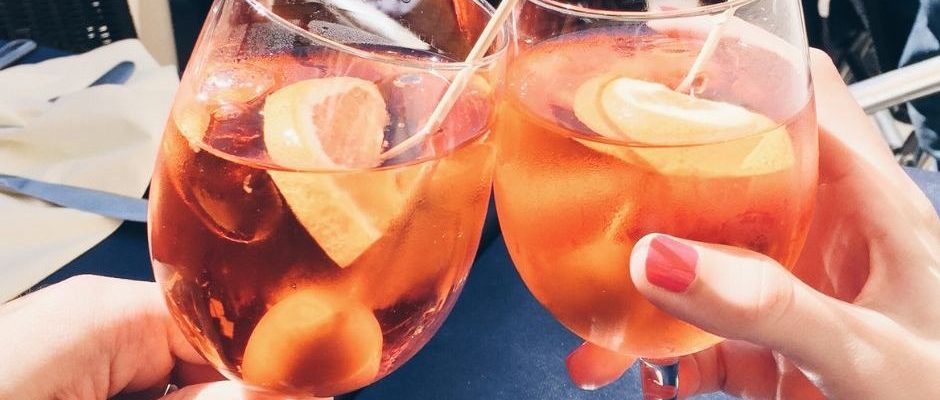2016. Summer France only vibrates around two passions: Antoine Griezmann and grapefruit rosé. If the first still delighted us with a master class at the 2022 World Cup (except in the final), fruity wine has long since deserted our aperitifs, relegated to the rank of ephemeral fashion, a little shameful like alcoholic Tecktonik. It is an understatement to say that we predicted roughly the same disastrous fate for the spritz, also the author of a hype a year earlier.
From 10,000 liters sold in France in 2011, the Italian drink rose to 750,000 liters in 2015. Since then, the drink has never lost its reputation as a fad or trend of the moment. But here we are already in 2023, eight years after the spritz maniaand Aperol, far from having disappeared, continues to color the terraces in summer.
Spritz Autopsy
Whether you like it or not – within the editorial staff of 20 minutes, we know that the subject divides – you might as well do it: the bugger seems to be here to stay. In 2023, it even entered the top 10 most drunk cocktails in the country, according to a study by out-of-home drinking experts CGA with panelist Nielsen. A durability which is not surprising when one embarks on the autopsy of the spritz, which has quite a few elements of a lasting success.
“The sparkling cocktail has always worked well in France”, first notes Clémentine Hugol-Gential, professor and specialist in contemporary food issues at the University of Burgundy. 18% of French people appreciate this kind of mix, compared to only 9% of Spaniards for example, indicates Julien Veyron, director of customer solutions at CGA-France. Another well-known success for Clémentine Hugol-Gential: the bitter taste, real current hype – we had already approached it for chocolate or IPA beer.
The power of terraces
To praise the orange drink, it’s hard to compete with the verve of Sylvain Greiner, director of operations at Eataly, temple of Italian gastronomy in Paris. “The spritz is perfectly adapted to the current consumption of young people: light and on the terrace. It’s not a cocktail that knocks you down or that you go to a nightclub, like a mojito can be. You can take a spritz and be well afterwards, which allows you to take a second and make the moment last”, especially since the spirits are often cheaper than a classic cocktail – and more voluminous. We come back to the pleasure of strolling for hours on the terraces version DolceVita. “The spritz has an unbeatable pleasure/price ratio! », enthuses Sylvain Grenier. In high season, this drink alone represents 20% of the alcoholic consumption of his establishment.
It only takes a grain of sunshine to see orange glasses bloom. And precisely, the very colorful aspect also explains its success. “It catches the eye, is very instagrammable and attracts curiosity. A spritz can be spotted,” notes Clémentine Hugol-Gential. That’s good, according to the CGA-Nielsen study, the image of the cocktail can motivate the choice of a drink when going out for 30% of consumers. “We find a bit of this aspect in the Moscow mule, with a metal glass that clashed in the bars”, recalls Sylvain Greinier.
Colors and the city
Curiosity about this new colorful drink was at the heart of Campari’s strategy, an essential brand for the strong comeback of the Venetian drink. The technique is well established, and now well informed: launch the spritz in the trendiest bars in the city center, wait for the hype to rise in other districts, then extend it to the entire town. No wonder the typical profile of the spritz aficionado is a young urbanite between 18 and 35 years old with an income slightly above average, according to Julien Veyron: “These are individuals who are determined to consume outside and have fun. Another strength of the cocktail to settle in time: it is unisex. Count 55% of female consumers, and 45% of men.
The madness of terraces and out-of-home consumption – the CHR (café, hotel, restaurant) – is boosting all cocktails, develops the expert: “Beer has not regained its 2019 volumes, where cocktails and spirits exceeded their pre-pandemic performance. CHR sales have been driven by young people since the Covid-19 crisis, who are less keen on pints.
The “easiest cocktail in the world”
This damn coronavirus, we always come back to it. “It can partly explain the success of the spritz”, even believes Sylvain Greinier. While terraces and bars were put on hold, “the spritz remains the easiest cocktail in the world to make at home”. Mix three ingredients – at affordable prices – and you’re done (for the bottom two that don’t follow: a slice of orange, Aperol, prosecco and sparkling water)*.
The fact remains that the pandemic now seems far away, and that this very sad month of May, a weather level until then has finally just remembered that it had the right to have a brilliant blue sky and a bright sun. The spritz is about to break into a new summer, the ninth in a row. Just look at the bar menus to be convinced, the drink now has its place alongside mojitos and other darons of the cocktail-game. “Just like the mojito, moreover, the spritz now has menus entirely its own, where it is available in various versions: the classic Aperol, the Saint-Germain, the Limoncello…”, lists Julien Veyron. “And then, the grapefruit rosé was really disgusting,” says Louise, who is sipping her spritz on the terrace. Maybe we should have started there.
* We remind you that alcohol abuse is dangerous for your health.

